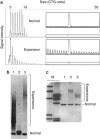Best practice guidelines and recommendations on the molecular diagnosis of myotonic dystrophy types 1 and 2
- PMID: 22643181
- PMCID: PMC3499739
- DOI: 10.1038/ejhg.2012.108
Best practice guidelines and recommendations on the molecular diagnosis of myotonic dystrophy types 1 and 2
Abstract
Myotonic dystrophy is an autosomal dominant, multisystem disorder that is characterized by myotonic myopathy. The symptoms and severity of myotonic dystrophy type l (DM1) ranges from severe and congenital forms, which frequently result in death because of respiratory deficiency, through to late-onset baldness and cataract. In adult patients, cardiac conduction abnormalities may occur and cause a shorter life span. In subsequent generations, the symptoms in DM1 may present at an earlier age and have a more severe course (anticipation). In myotonic dystrophy type 2 (DM2), no anticipation is described, but cardiac conduction abnormalities as in DM1 are observed and patients with DM2 additionally have muscle pain and stiffness. Both DM1 and DM2 are caused by unstable DNA repeats in untranslated regions of different genes: A (CTG)n repeat in the 3'-UTR of the DMPK gene and a (CCTG)n repeat in intron 1 of the CNBP (formerly ZNF9) gene, respectively. The length of the (CTG)n repeat expansion in DM1 correlates with disease severity and age of onset. Nevertheless, these repeat sizes have limited predictive values on individual bases. Because of the disease characteristics in DM1 and DM2, appropriate molecular testing and reporting is very important for the optimal counseling in myotonic dystrophy. Here, we describe best practice guidelines for clinical molecular genetic analysis and reporting in DM1 and DM2, including presymptomatic and prenatal testing.
Figures


References
-
- The International Myotonic Dystrophy Consortium (IDMC) New nomenclature and DNA testing guidelines for myotonic dystrophy type 1 (DM1) Neurology. 2000;54:1218–1221. - PubMed
-
- Harper PS.Myotonic Dystrophy3rd edn, Harcourt Publishers Ltd: London; 2001
-
- Groh WJ, Groh MR, Saha C, et al. Electrocardiographic abnormalities and sudden death in myotonic dystrophy type 1. N Engl J Med. 2008;358:2688–2697. - PubMed
-
- Day JW, Roelofs R, Leroy B, Pech I, Benzow K, Ranum LP. Clinical and genetic characteristics of a five-generation family with a novel form of myotonic dystrophy (DM2) Neuromuscul Disord. 1999;9:19–27. - PubMed
Publication types
MeSH terms
Substances
LinkOut - more resources
Full Text Sources
Other Literature Sources
Medical
Miscellaneous

